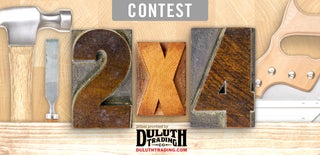Introduction: Campaign Desk
A campaign desk is a nomadic writing table, popularized by officers of the British Empire in the colonial-minded 1800s. Wealthy officers, who often bought their commissions from the Crown (as opposed to actually training as soldiers), furnished their field tents with teak or mahogany chests, cots, and desks. Many designs featured clever friction fittings or break-down leg systems to keep the officer's possessions (and person) up off of the damp ground. A style evolved, heavy on brass and canvas fixtures, that has now become a commercialized "look" without any of the original core functionality.
This modern take on the campaign desk restores the portability and simplicity of the original campaign furniture. It also copies a structural strategy used by many early campaign desks. Instead of using an apron (a perimeter run of boards under a table to stiffen the top), desks were built as boxes that both held the writing supplies and acted as a self-contained structural unit. The sawhorses are a leaner, meaner update on the usual slapped-together shop workhorses, made from salvaged lumber. Offset legs make for simple overlay joinery and allow the finished units to nestle neatly together.
The result is an expansive, super-sleek command center for the modern knowledge worker. There's plenty of space for a king-sized monitor, scanner, secondary laptop, and all the other accessories of digital life.
Depending on the grade of plywood you choose, this whole desk can be made for about $50.
You will need these tools:
- Tape measure
- Square
- Pencil
- Table saw with dado blade set
- Cross cut sled
- Circular saw
- Drill/driver
- Chop saw
- Bandsaw
- Router or router table (optional)
- Clamps
- Straightedge
- Orbital sander
- Paintbrush
You will need these materials:
- 1 3/4" by 4x8 sheet of plywood, birch preferred
- Roughly 9' of reclaimed 2x4 material
- Wood glue
- Brushing lacquer, polyurethane, or finish of your choice
- Furniture wax
Step 1: Desk Top Cuts
The main desk is made up of just four parts: the surface, two identical sides, and a back.
Start by cutting the surface. Use a circular saw and a clamped straightedge to cut it down to 66" long. Run the remaining piece through the table saw lengthwise to rip it to 28". The resultant piece should be 66" by 28".
The long offcut should be 20" x 66". Rip it half to 10" wide by 66" long. Set one piece aside for the back of the desk. Swap out the table saw blade for a dado set.
For the sides, use a crosscut sled and a dado sled to make a 1-5/8"-wide, 3/8"-deep dado down the center (at 33") of the remaining 66" x 10" offcut. Then cut in a 3/4"-wide, dado 4" up from one of the long sides of both pieces. All of the dados will interlock to make strong corners and stiffen the desk surface without the use of a more traditional apron.
Swap the dado set back in. Use a crosscut sled to cut the side piece in half (at 33"), right down the center of the short dado. Measure 10" from one end, and 5-3/4" up from the other (see picture for notes). Connect the marks, Cut the taper on the bandsaw. Made sure you make the sides as mirror images of one another.
I put in a shelf in one corner for a scanner. This is optional; if you want to do it, cut a 3/4" piece of leftover stock to 12" x 4" and two 1/2" pieces at 12" x 16" and 12" x 15-1/4".
Step 2: Desk Assembly
Before assembly, sand all the edges. I sanded all of the edges on a disc sander. This is not the ideal tool for a piece with so many long edges -- I would recommend a true edge sander at least 4' long. Then, smooth the surfaces with 120-grit sandpaper and an orbital sander. The birch ply was already decent quality and didn't need a lot of work; if you're working with a lower-grade plywood, start with 100-grit.
To assemble, lay glue in the dado on the back. Spread with your finger so it coats both the bottom and the shoulders of the dado evenly. Position the surface of the desk so the back edge is hanging over the table and push the back on so that the back edge of the desk surface is seated firmly in the dado. Use clamps and a mallet to persuade the pieces to fit together as necessary. Secure the back by pre-drilling and screwing with Spax MDF screws, which are designed to go into the end grain of plywood without splitting. I left the screws exposed; if you want a cleaner presentation, over-countersink the screws and plug with a dowel and some glue.
Repeat for the sides, taking care that the backs of the sides capture the edges of the back piece.
Add an optional shelf in the corner, and drill a cord hole in the center of the desk surface close to the back. Finish with two coats of lacquer and one coat of furniture wax.
Step 3: Sawhorse Cuts
These sawhorses were a collaboration with Professor Arman Mizani, manager of the Surface Project at the Station North Tool Library.
We made the legs with reclaimed pine 2x6s. To neaten up the wood, take a 1/4" off of each side of your stock with the table saw. Then, using the chop saw, cut into 28" blanks at a 5 degree miter. The miters should be parallel to one another. Make 4 blanks.
Using tapered legs makes for a sleeker, better-looking sawhorse and is more materially efficient, allowing for two legs to be made out of each blank. These taper from 1-1/2" at one end to 3-1/2" at the other. Make a pencil mark across one end at 1-1/2" in from one edge. Do the same at the other end, from the opposite edge. Connect the marks. Set the taper leg jig up to cut that line straight. There are lots of ways to make taper-leg jigs; here's a good simple one. Split all the blanks in half.
An optional, but nice step, is to run all the edges through a router table with a chamfer or roundover bit to clean up any splinters.
Last, make 2 top plates by running 24" blanks through the table saw set at a 5 degree miter. The bevels should be opposite one another and take off as little material as possible.
Step 4: Sawhorse Assembly
Lay one leg on top of another with some wood glue in between. Line them up so the fat ends line up perfectly one on top of another with the cut miters flush. Secure with at least two counter-sunk 3" drywall screws or similar, staggered vertically. I actually used some galvanized hex-head roofing screws because they were salvaged (and free), but deck screws, machine bolts, or lag bolts would all work. Assemble four A-frames this way.
Stand one set of A-frames up. Secure the top plate flush to the top of the A-frame with glue and screws. The end of the top plate should be flush with the outside surface of the A-frame. Repeat on the other side with the other A-frame. The finished pair should be able to nest together, one set of legs fitting into the other.
These sawhorses are plenty sturdy for this lightweight desk, but the lack of bottom brace or trestle make them susceptible to some lateral instability.
To assemble desk, put it on the ground upside down. Screw the sawhorses onto the bottom with two 2" drywall screws each. With a friend, flip over carefully without pausing to rest on the legs at an angle.
Sit down and get to work!

Participated in the
Full Spectrum Laser Contest 2016

Participated in the
2x4 Contest













